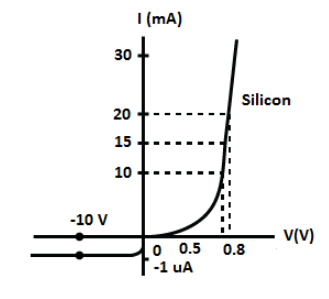
The V-I characteristics of a silicon diode is shown in the figure. Calculate the resistance of the diode at
(a) \[{I_D} = 15\,{\text{mA}}\] and
(b) \[{V_D} = - 10\,{\text{V}}\]


Answer
471k+ views
Hint:The inverse of the slope of curve in the V-I graph is the resistance of the diode. Use Ohm’s law to express the resistance of the diode and find the relation between resistance and slope of the curve. For the second part, the change in current is \[ - 1\,\mu A\].
Formula used:
According to Ohm’s law the resistance of the diode is given as,
\[R = \dfrac{{\Delta V}}{{\Delta I}}\]
Here, \[\Delta V\] is the potential across the diode and \[\Delta I\] is the change in the current.
Complete step by step answer:
We have from Ohm’s law the resistance of the diode is given as,
\[R = \dfrac{{\Delta V}}{{\Delta I}}\]
Here, \[\Delta V\] is the potential across the diode and \[\Delta I\] is the change in the current.
Therefore, if we look at the V-I graph of the diode, the resistance is the reciprocal of the slope of the curve. Thus, we can write,
\[R = \dfrac{1}{m} = \dfrac{{{V_2} - {V_1}}}{{{I_2} - {I_1}}}\]
Here, m is the slope of the curve.
(a) At \[{I_D} = 15\,{\text{mA}}\], let’s find the resistance of the diode as follows,
\[R = \dfrac{{{V_2} - {V_1}}}{{{I_2} - {I_1}}}\]
Substituting 0.8 for \[{V_2}\], 0.7 for \[{V_1}\], 20 A for \[{I_2}\] and 10 A for \[{I_1}\] in the above equation, we get,
\[R = \dfrac{{0.8 - 0.7}}{{\left( {20 - 10} \right) \times {{10}^{ - 3}}}}\]
\[ \therefore R = 10\,\Omega \]
Therefore, the resistance of the diode is \[10\,\Omega \].
(b) At \[{V_D} = - 10\,{\text{V}}\], let’s find the resistance of the diode as follows,
\[R = \dfrac{{{V_2} - {V_1}}}{{{I_2} - {I_1}}}\]
Substituting \[ - 10\,{\text{V}}\] for \[{V_2}\], 0 V for \[{V_1}\], \[ - 1\,\mu A\] for \[{I_2}\] and 0 A for \[{I_1}\] in the above equation, we get,
\[R = \dfrac{{ - 10 - 0}}{{\left( { - 1 - 0} \right) \times {{10}^{ - 6}}}}\]
\[ \therefore R = {10^5}\,\Omega \]
Therefore, the resistance of the diode at \[{V_D} = - 10\,{\text{V}}\] is\[{10^5}\,\Omega \].
Note: In I-V characteristics graph, always denote the voltage along the x-axis and current along the y-axis. The reciprocal of the slope is the resistance of the diode and not the slope of the curve. Note that the resistance of the diode is always the positive quantity.
Formula used:
According to Ohm’s law the resistance of the diode is given as,
\[R = \dfrac{{\Delta V}}{{\Delta I}}\]
Here, \[\Delta V\] is the potential across the diode and \[\Delta I\] is the change in the current.
Complete step by step answer:
We have from Ohm’s law the resistance of the diode is given as,
\[R = \dfrac{{\Delta V}}{{\Delta I}}\]
Here, \[\Delta V\] is the potential across the diode and \[\Delta I\] is the change in the current.
Therefore, if we look at the V-I graph of the diode, the resistance is the reciprocal of the slope of the curve. Thus, we can write,
\[R = \dfrac{1}{m} = \dfrac{{{V_2} - {V_1}}}{{{I_2} - {I_1}}}\]
Here, m is the slope of the curve.
(a) At \[{I_D} = 15\,{\text{mA}}\], let’s find the resistance of the diode as follows,
\[R = \dfrac{{{V_2} - {V_1}}}{{{I_2} - {I_1}}}\]
Substituting 0.8 for \[{V_2}\], 0.7 for \[{V_1}\], 20 A for \[{I_2}\] and 10 A for \[{I_1}\] in the above equation, we get,
\[R = \dfrac{{0.8 - 0.7}}{{\left( {20 - 10} \right) \times {{10}^{ - 3}}}}\]
\[ \therefore R = 10\,\Omega \]
Therefore, the resistance of the diode is \[10\,\Omega \].
(b) At \[{V_D} = - 10\,{\text{V}}\], let’s find the resistance of the diode as follows,
\[R = \dfrac{{{V_2} - {V_1}}}{{{I_2} - {I_1}}}\]
Substituting \[ - 10\,{\text{V}}\] for \[{V_2}\], 0 V for \[{V_1}\], \[ - 1\,\mu A\] for \[{I_2}\] and 0 A for \[{I_1}\] in the above equation, we get,
\[R = \dfrac{{ - 10 - 0}}{{\left( { - 1 - 0} \right) \times {{10}^{ - 6}}}}\]
\[ \therefore R = {10^5}\,\Omega \]
Therefore, the resistance of the diode at \[{V_D} = - 10\,{\text{V}}\] is\[{10^5}\,\Omega \].
Note: In I-V characteristics graph, always denote the voltage along the x-axis and current along the y-axis. The reciprocal of the slope is the resistance of the diode and not the slope of the curve. Note that the resistance of the diode is always the positive quantity.
Recently Updated Pages
Master Class 12 Social Science: Engaging Questions & Answers for Success

Class 12 Question and Answer - Your Ultimate Solutions Guide

Class 10 Question and Answer - Your Ultimate Solutions Guide

Master Class 10 Science: Engaging Questions & Answers for Success

Master Class 10 Maths: Engaging Questions & Answers for Success

Master Class 9 General Knowledge: Engaging Questions & Answers for Success

Trending doubts
The gas that burns in oxygen with a green flame is class 12 chemistry CBSE

The probability that a leap year will have only 52 class 12 maths CBSE

Describe the poetic devices used in the poem Aunt Jennifers class 12 english CBSE

And such too is the grandeur of the dooms We have imagined class 12 english CBSE

What does the god that failed refer to class 12 english CBSE

Which country did Danny Casey play for class 12 english CBSE




